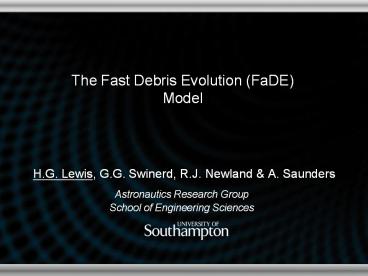The Fast Debris Evolution (FaDE) Model PowerPoint PPT Presentation
1 / 25
Title: The Fast Debris Evolution (FaDE) Model
1
The Fast Debris Evolution (FaDE) Model
- H.G. Lewis, G.G. Swinerd, R.J. Newland A.
Saunders
Astronautics Research Group School of Engineering
Sciences
2
Outline
- Motivation Aims
- The FADE-? Model
- Comparison with Talents 1992 PIB Model
- Results
- Summary
3
Motivation
- The future debris environment is traditionally
characterised using a few key descriptors, e.g. - Effective number of objects
- Number of collisions
- The impact of space operations on the debris
environment can be addressed by answering broad
questions, e.g. - Has the number of objects increased or decreased?
- How has the number of objects increased or
decreased?
4
Motivation
- Evolutionary models typically use Monte Carlo
simulation - Many runs required for reliable distributions
- Mean and standard deviations usually reported
5
Motivation
- Evolutionary models typically use Monte Carlo
simulation - Many runs required for reliable distributions
- Mean and standard deviations usually reported
6
Aim
- Reduce the effort required to capture basic
descriptors of the future environment - Reduce/remove the need for many MC runs
- Maintain accuracy of forecasts
- Identify interesting cases quickly
- Use full, 3-D models to explore outliers
- Characterise runs by their differences from the
average - Improve accessibility to future projections
- Flexibility
- Explore different scenarios
- Explore sensitivity to intitial conditions
- Provide outreach possibilities
7
FaDE Approach
- Describe debris evolution using an equation of
motion/intitial value problem - Estimate values of N for t gt 0 using Eulers
method - Include debris species
- Intacts
- Explosion fragments
- Collision fragments
( yr-1)
( yr-1)
8
FaDE Approach
- Intacts
- Explosion fragments
- Collision fragments
( yr-1)
( yr-1)
9
FaDE Approach Launches, Explosions Removals
- L represents the product of launch rate and
number of intacts per launch (similar definition
for E) - Value of D is species-dependent
- Coefficients L, E, D define basic scenario
10
FaDE Basic User Interface
Blurb
Graphical output
Control Panel
Graph options
11
FaDE Approach Collisions
- Random collisions account for the biggest
difference between MC runs in DAMAGE - Number
- Timing
- Energy
- Need to capture the average collision and
collision rate
12
FaDE Approach Collisions
- Collision probability from DAMAGE
13
FaDE Approach Collisions
- Collision probability from DAMAGE No new
launches after 2000 (1957 2040)
R2 0.9677
14
FaDE Approach Collisions
- Empirical model for insertion of collision
fragments derived from DAMAGE - A, B, C are coefficients defining collision
frequency - F is the average number of fragments produced by
a collision
15
FaDE Initial Conditions
- Defined using 60 MC DAMAGE runs of a No new
launches after 2000 (1957 2040) scenario
Parameter Value
Projection period 1957 2040
No new launches after 2000
Time-step 5 days
Minimum object size 10 cm
Collision prediction cube size 10 km
Collision prediction active from 1957
Explosions Only confirmed explosions of objects launched prior to 2000 allowed
16
FaDE Initial Conditions from DAMAGE
- No new launches after 2000 (1957 2040)
- Number of objects ? 10 cm
17
FaDE Initial Conditions from DAMAGE
- No new launches after 2000 (1957 2040)
- Number of collisions
18
FaDE Comparison With Talent (1992)
- FADE
- Talent (1992) Eqn. 1
- Roots of the equation (dN/dt 0)
- Determined by
- Identify source and sink terms
- Understand behaviour
19
FaDE Testing Comparison with DAMAGE
- Two scenarios
- Business as usual (1957 2040)
Parameter Value
Projection period 1957 2040
Traffic model (2000 2040) Based on launch statistics for 1996-2001
Future explosions (2000 2040) Based on explosion statistics for 1996 - 2001
Time-step 5 days
Minimum object size 10 cm
Collision prediction cube size 10 km
Collision prediction active from 1957
20
FaDE Testing Comparison with DAMAGE
- Two scenarios
- No new launches after 2000 (1957 2200)
Parameter Value
Projection period 1957 2200
No new launches after 2000
Time-step 5 days
Minimum object size 10 cm
Collision prediction cube size 10 km
Collision prediction active from 1957
Explosions Only confirmed explosions of objects launched prior to 2000 allowed
21
FaDE Comparison with DAMAGE
- Business as usual (1957 2040)
- Number of objects ? 10 cm
22
FaDE Comparison with DAMAGE
- Business as usual (1957 2040)
- Number of collisions
23
FaDE Comparison with DAMAGE
- No new launches after 2000 (1957 2200)
- Number of objects ? 10 cm
24
FaDE Comparison with DAMAGE
- No new launches after 2000 (1957 2200)
- Number of collisions
25
Summary
- FaDE captures the evolution of basic environment
characteristics - Tuned using one or more MC runs
- Tuning is currently trial-and-error
- Automatic approach to be adopted
- Easy to access and use
- Allows quick forecasts
- Can identify important outliers in DAMAGE runs
- FaDE-? improves information output

